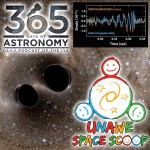Podcaster: Richard Drumm
 Title: Space Scoop: Black Holes Make Waves Across The Universe
Title: Space Scoop: Black Holes Make Waves Across The Universe
Organization: 365 Days Of Astronomy
Link : astrosphere.org ; http://unawe.org/kids/unawe1605/
Description: Space scoop, news for children.
Bio: Richard Drumm is President of the Charlottesville Astronomical Society and President of 3D – Drumm Digital Design, a video production company with clients such as Kodak, Xerox and GlaxoSmithKline Pharmaceuticals. He was an observer with the UVa Parallax Program at McCormick Observatory in 1981 & 1982. He has found that his greatest passion in life is public outreach astronomy and he pursues it at every opportunity.
Today’s sponsor: This episode of “365 Days of Astronomy” is sponsored by — no one. We still need sponsors for many days in 2015, so please consider sponsoring a day or two. Just click on the “Donate” button on the lower left side of this webpage, or contact us at signup@365daysofastronomy.org.
Transcript:
This is 365 Days of Astronomy. Today we bring you a new episode in our Space Scoop series. This show is produced in collaboration with Universe Awareness, a program that strives to inspire every child with our wonderful cosmos.
Today’s story is:
Black Holes Make Waves Across The Universe
Scientists have directly detected gravitational waves for the first time!
Gravitational waves are ‘ripples’ in the very fabric of the Universe. These ripples are caused by violent and energetic events in space, like black holes or neutron stars colliding, stars exploding and even the birth of the Universe itself.
Albert Einstein predicted that gravitational waves exist, back in June of 1916. But actual proof of their existence didn’t arrive until almost 100 years later.
On September 14th, 2015 gravitational waves were directly detected for the very first time. Gravitational waves had been indirectly detected before, but this was a direct detection.
These gravitational waves were produced over 1.3 billion years ago when two massive black holes collided. They were 1.3 billion light years away too, as you might guess.
So quite literally, this happened a long time ago in a galaxy far, far away!
Two black holes of 29 and 36 solar masses were orbiting each other and collided or merged into a bigger black hole. So you’d think that the new black hole would be 29 + 36 or 65 solar masses, but no.
In the process of merging they lost about 3 solar masses to the energy that created the gravitational wave. 3 solar masses goes POOF! And it’s gone. E=MC2 The matter is converted into energy.
Light & matter can’t leave a black hole, but gravitational waves sure can!
By the way, the term “gravity wave” is reserved for fluid dynamics. The waves at the beach, caused by the wind, those are gravity waves.
The collision rang spacetime like a bell, but in reverse. A bell ring starts strong and tapers off. This event started slowly and ended with a bang. As it did, gravitational waves travelled outwards in every direction, like sound waves emanating from a hand clap.
I wonder what it would have been like to be a few dozen light years away from it. You’d probably have felt it. Your world might’ve seemed like a fun house mirror for a moment.
Although their birth was extremely violent, by the time the gravitational waves reached Earth they were absolutely minuscule — 1/1,000 the diameter of a proton!
To have any hope of detecting them, we needed the most sensitive measuring tools in the Galaxy: the LIGO interferometers.
There are two LIGO instruments, one in Hanford, Washington, and the other in Livingston, Louisiana. Each one is made up of an L-shaped tunnel and the 2 arms that make up the “L” are 4 kilometers long.
Laser beams shine back and forth down the tunnels. Using these beams it’s possible to measure the length of the tunnel very precisely.
As gravitational waves pass through Earth they stretch and squash the planet ever so slightly. This causes a tiny change in the length of the LIGO tunnels.
Measuring this change is how we spotted the gravitational waves and finally proved, beyond a doubt, that Einstein was indeed, once again, correct!
The 2 LIGO installations basically create 2 graphs of waves that look like noise and bear no relation to each other. Quite random.
Then about 3 minutes before the crest of the wave hit, computers alerted operators that something was happening.
Then for 1/8 of a second the 2 detectors show very similar graphs. The frequency and amplitude both increased with the peaks coming faster and higher, faster and higher!
And then it was all over and the graphs looked different from each other again. Just random noise.
The time the 2 events were recorded was slightly different as the gravitational wave was traveling at the speed of light as it passed first through Louisiana and then through Washington about 4.3 milliseconds later.
Hey, Here’s A Cool Fact:
When these two black holes collided they gave off more power than the light from all the stars and galaxies in the visible Universe…multiplied by ten! No light, just the gravity wave. But it was only that 1/8 of a second.
Thank you for listening to 365 Days of Astronomy!
End of podcast:
365 Days of Astronomy
=====================
The 365 Days of Astronomy Podcast is produced by Astrosphere New Media. Audio post-production by Richard Drumm. Bandwidth donated by libsyn.com and wizzard media. You may reproduce and distribute this audio for non-commercial purposes. Please consider supporting the podcast with a few dollars (or Euros!). Visit us on the web at 365DaysOfAstronomy.org or email us at info@365DaysOfAstronomy.org. This year we will celebrate more discoveries and stories from the universe. Join us and share your story. Until tomorrow! Goodbye!

